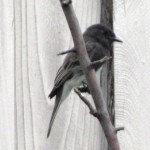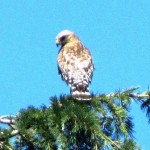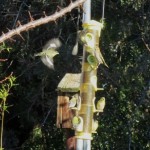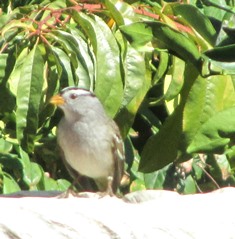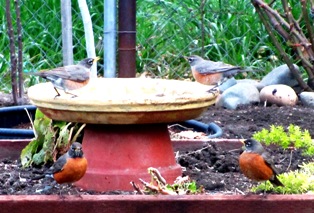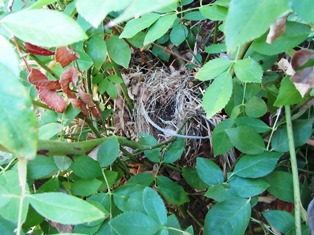How to Attract Birds to Make Your Garden a Sanctuary
A Chinese proverb states that “If I keep a green bough in my heart, then the singing bird will come.” I think I was born with that green bough in my heart because I have always loved birds–and not only the songbirds.
By offering food, water, and safe and dry housing as well as blooms for every season (flowering annuals, perennials, herbs, bulbs, and fruits and berries), I am able to attract many different birds into my garden.When birds are present, especially the songbirds, the garden becomes a special sanctuary.
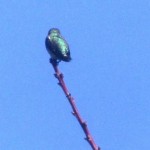
A hummer’s iridescent feathers shimmer as it perches in sunlight at the end of an apricot tree branch
I hang feeders and fill them with various types of seed and suet cakes as well as syrup for hummingbirds. Food attracts local and migratory birds flying through this time of year. It’s best to choose a wide sampling of foods such as seeds, nuts,hulled sunflower, safflower, Nyjer thistle, peanut, millet, fruit, berries, raisins, and meal worms to draw interesting bird traffic.
Some of the birds we regularly see include scrub jays, wrens, finches, sparrows, red-tail hawks, mockingbirds, quail, mourning doves, robins, barn owls, hummingbirds, and crows.
With food scarce in the wild, the birds visit the hanging and platform feeders. For ground feeders like mourning doves, I put out a large saucer under the apple tree and, yes, I leave a few apples on the tree for the birds to peck. For a list of birds and the types of seed and other foods they consume, see, https://www.wild-bird-watching.com/Bird_Seed.html
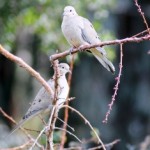
Mourning doves mate for life; these two are joined at the feeder by a third who has lost his or her partner
Some of our winged visitors stick around to mate and build nests in climbing rose bushes, brush piles, trees, or one of the many birdhouses we’ve hung. Only the owl basket high in the pepper tree remains empty, but we’ve heard a lot of hooting at night so we’re optimistic that owls will take up residence here. We live close to designated agricultural lands and the empty field behind us has a lot of mice–their favorite food.

My hubby built this birdhouse from a fence board. Not all birds will take up residence in a house, but many will.
Birds build nests in backyard birdhouses and brush piles as well as in trees, shrubs like climbing roses, and under the protected eaves of buildings (mourning doves especially seem to like these). Hummingbirds will build their tiny cup-like nests in shrubs (we found one in our Cecil Brunner climbing rose bush) and trees, from 10 feet and up in locations where wind isn’t a threat.
A water source is important for attracting birds since they both drink and bathe in the water fountains and bird baths of backyards and gardens.
If you provide food, water, and a safe and dry shelter for the birds to eat, breed, and nest, you will be rewarded for not only the singing birds will come but other interesting species as well.
_______________________________________________________
If you enjoy reading about living close to the earth and a good yarn, check out my Henny Penny Farmette series of cozy mysteries: A BEELINE TO MURDER, THE MURDER OF A QUEEN BEE, and my latest, A HIVE OF HOMICIDES.
These mysteries are chock-full of tips for keeping chickens and bees, growing heirloom fruits and vegetables, and backyard DIY projects. For more information, click on the URL.
A HIVE OF HOMICIDES
Those Entertaining Rascals, the Sparrows
I enjoy watching the sunrise over the hills that jut up between the inland valley of the East Bay, where I live, and the waters of the delta flowing down from Sacramento to dump into the Straits of Carquinez before entering the San Francisco Bay. A lot goes on in our backyard garden at sunrise.
With feeders filled with birdseed, all sorts of songbirds visit to eat before bathing in the bird bath perched in a raised bed of blooming geraniums, asparagus ferns, and foxglove flowers. The squirrels search feeders for sunflower seeds. And clusters of house sparrows twitter away as they forage for seeds, insects and other interesting morsels to devour.
These cutie pies descend to the lawn as soon as the sun is up. They bathe, drink, and eat, often stealing food from other birds. A robin with a beak full of worms better take heed of the presence of sparrows or those little cheep, cheep, cheepers will steal the food right out of the robin’s beak.
The sparrow’s thievery isn’t limited to food; no, it will also steal nesting material from each other’s nest. But these scrappy little fellows will just as readily engage in their birdbrain version of fisticuffs as they will dart into trees for cover.
Without a doubt, of all the birds that are visiting the garden of late, the sparrows provide hours of entertainment.
Forget the Lawn and Welcome the Robins
One of my favorite ways to relax is birdwatching. And nothing entertains me more than seeing an orange-breasted robin hopping around on the lawn and then halting at a full stop with its head cocked as if listening for an earthworm, as if the worms telegraphed their presence. I mean seriously. But somehow, those robins will find the worms and pull them right out of the ground.
When winter is nearing its close and spring is beginning, the robins are one of the first harbingers of the seasonal transition. In the spring, when other backyard birds are nesting and producing young, the robins are, too. But even though it is possible for them to produce three broods each year, less than half (40 percent) of their nests will hold baby robins.
Of the young robins that hatch, only about a quarter of them will make it to November each year. And as if that weren’t bad enough, of the robins that make it through a full year, only half will survive through a second year. And yet, robins can live to the ripe old age of 14 if it were not for predators and pesticides.
With the odds against these sweet birds’ survival, you’d think most people would not spray the daylights out of their lawns with pesticides and herbicides. These chemicals are toxic to the robins as well as other birds and, of course, the beleaguered honeybee.
Robins find lawns to be wonderful sites for foraging and I often see them searching and snatching the earthworms in the early morning. Later in the day, these cheerful birds seem to prefer fruit and honeysuckle berries. If you don’t see them, you might hear their cheery song crisp and clear, even over urban noise.
During certain times of the year, you might see the robins in greater numbers than at other times, but that doesn’t mean they’ve gone far. They are either resident birds, meaning they stay close to their breeding area or are short-distance migrants. The local conditions (environmental, weather, water and food availability, predator populations, and other factors) dictate the size of the robin population in at any given time in a particular area.
If you love birds as I do, less fussing over your lawn (except to encourage the worms) might mean having having more robins around. Consider ways to establish a healthy ecological balance in your yard and garden to avoid spraying with chemicals that can poison these cheerful fun-to-watch birds.
 Facebook
Facebook Goodreads
Goodreads LinkedIn
LinkedIn Meera Lester
Meera Lester Twitter
Twitter



